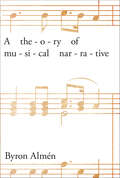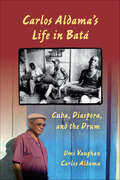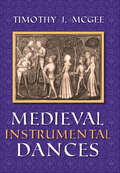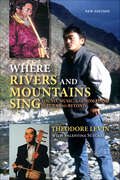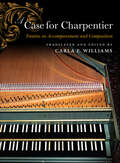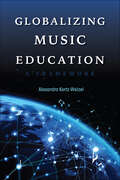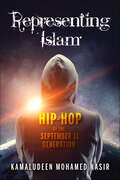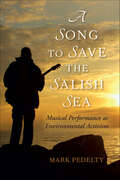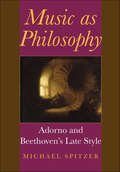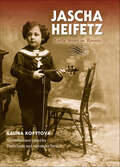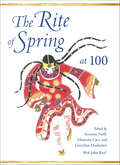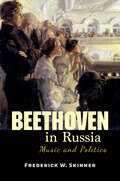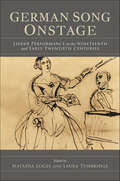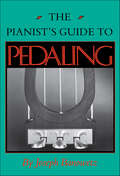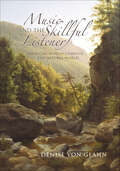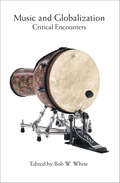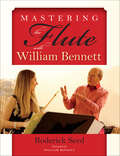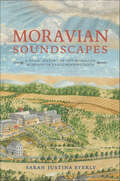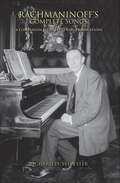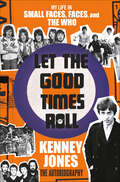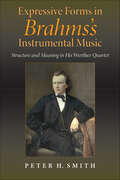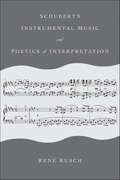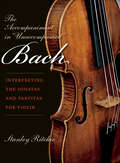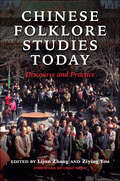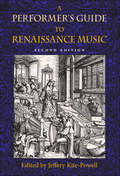- Table View
- List View
A Theory of Musical Narrative (Musical Meaning and Interpretation)
by Byron AlménByron Almén proposes an original synthesis of approaches to musical narrative from literary criticism, semiotics, historiography, musicology, and music theory, resulting in a significant critical reorientation of the field. This volume includes an extensive survey of traditional approaches to musical narrative illustrated by a wide variety of musical examples that highlight the range and applicability of the theoretical apparatus. Almén provides a careful delineation of the essential elements and preconditions of musical narrative organization, an eclectic analytical model applicable to a wide range of musical styles and repertoires, a classification scheme of narrative types and subtypes reflecting conceptually distinct narrative strategies, a wide array of interpretive categories, and a sensitivity to the dependence of narrative interpretation on the cultural milieu of the work, its various audiences, and the analyst. A Theory of Musical Narrative provides both an excellent introduction to an increasingly important conceptual domain and a complex reassessment of its possibilities and characteristics.
Carlos Aldama's Life in Batá: Cuba, Diaspora, and the Drum
by Umi Vaughan Carlos AldamaBatá identifies both the two-headed, hourglass-shaped drum of the Yoruba people and the culture and style of drumming, singing, and dancing associated with it. This book recounts the life story of Carlos Aldama, one of the masters of the batá drum, and through that story traces the history of batá culture as it traveled from Africa to Cuba and then to the United States. For the enslaved Yoruba, batá rhythms helped sustain the religious and cultural practices of a people that had been torn from its roots. Aldama, as guardian of Afro-Cuban music and as a Santería priest, maintains the link with this tradition forged through his mentor Jesus Pérez (Oba Ilu), who was himself the connection to the preserved oral heritage of the older generation. By sharing his stories, Aldama and his student Umi Vaughan bring to light the techniques and principles of batá in all its aspects and document the tensions of maintaining a tradition between generations and worlds, old and new. The book includes rare photographs and access to downloadable audio tracks.
Medieval Instrumental Dances
by Timothy J. McGeeIn Europe the tradition of secular dance has continued unbroken until the present. In the late Middle Ages it was an important and frequent event—for the nobility a gracious way to entertain guests, for the peasantry a welcome relaxation from the toils of the day. Now back in print, this collection presents compositions that are known or suspected to be instrumental dances from before ca. 1420. The 47 pieces vary in length and style and come from French, Italian, English, and Czech sources. Timothy McGee relates medieval dances to the descriptions found in literary, theoretical, and archival sources and to the depictions in the iconography of the Middle Ages. In a section on instrumental performance practices, he provides information about ornamenting the dances and improvising in a historically appropriate style. This comprehensive edition brings together in one volume a repertory that has been scattered over many years and countries.
Where Rivers and Mountains Sing: Sound, Music, and Nomadism in Tuva and Beyond
by Theodore Levin Valentina SüzükeiTheodore Levin takes readers on a journey through the rich sonic world of inner Asia, where the elemental energies of wind, water, and echo; the ubiquitous presence of birds and animals; and the legendary feats of heroes have inspired a remarkable art and technology of sound-making among nomadic pastoralists. As performers from Tuva and other parts of inner Asia have responded to the growing worldwide popularity of their music, Levin follows them to the West, detailing their efforts to nourish global connections while preserving the power and poignancy of their music traditions.
A Case for Charpentier: Treatise on Accompaniment and Composition (Historical Performance)
by Carla E. WilliamsWho originally authored the anonymous, undated French manuscript Traité d'accompagnement et de composition? Carla E. Williams tackles this mystery while providing the first English translation of this rare manuscript, which resides in the collections of the Lilly Library at Indiana University Bloomington. A Case for Charpentier presents a side-by-side transcription and translation of the treatise along with an introduction that offers historical context. In the manuscript itself, late 17th-century and early 18th-century writers discuss principal musical elements of composition including major and minor modes, the fundamental chords of both modes, dissonances and consonances, meter, tempo, and continuo realization, as well as basse continue. While these writers have not been formally identified, Williams argues that the handwriting of one is that of composer Marc-Antoine Charpentier. By providing a full physical description of the manuscript, along with comparisons of Charpentier's other writings and his handwriting, Williams sheds new light on both the treatise and Charpentier's theoretical writings. With this translation, Williams not only shares invaluable insights into the pedagogical approaches for composition and continuo realization in late 17th-century France but also finally makes Traité d'accompagnement et de composition available to a broader audience.
Globalizing Music Education: A Framework (Counterpoints: Music and Education)
by Alexandra Kertz-WelzelHow do globalization and internationalization impact music education around the world? By acknowledging different cultural values and priorities, Alexandra Kertz-Welzel's vision challenges the current state of international music education and higher education, which has been dominated by English-language scholarship. Her framework utilizes an interdisciplinary approach and emphasizes the need for developing a pluralistic mode of thinking, while underlining shared foundations and goals. She explores issues of educational transfer, differences in academic discourses worldwide, and the concept of the global mindset to help facilitate much-needed transformations in global music education. This thinking and research, she argues, provides a means for better understanding global transfers of knowledge and ways to avoid culturally and linguistically hegemonic standards. Globalizing Music Education: A Framework is a timely call to action for a more conscious internationalization of music education in which everyone can play a part.
Representing Islam: Hip-Hop of the September 11 Generation (Framing the Global)
by Kamaludeen Mohamed NasirHow do Muslims who grew up after September 11 balance their love for hip-hop with their devotion to Islam? How do they live the piety and modesty called for by their faith while celebrating an art form defined, in part, by overt sexuality, violence, and profanity? In Representing Islam, Kamaludeen Mohamed Nasir explores the tension between Islam and the global popularity of hip-hop, including attempts by the hip-hop ummah, or community, to draw from the struggles of African Americans in order to articulate the human rights abuses Muslims face. Nasir explores state management of hip-hop culture and how Muslim hip-hoppers are attempting to "Islamize" the genre's performance and jargon to bring the music more in line with religious requirements, which are perhaps even more fraught for female artists who struggle with who has the right to speak for Muslim women. Nasir also investigates the vibrant underground hip-hop culture that exists online. For fans living in conservative countries, social media offers an opportunity to explore and discuss hip-hop when more traditional avenues have been closed. Representing Islam considers the complex and multifaceted rise of hip-hop on a global stage and, in doing so, asks broader questions about how Islam is represented in this global community.
A Song to Save the Salish Sea: Musical Performance as Environmental Activism (Music, Nature, Place)
by Mark PedeltyOn the coast of Washington and British Columbia sit the misty forests and towering mountains of Cascadia. With archipelagos surrounding its shores and tidal surges of the Salish Sea trundling through the interior, this bioregion has long attracted loggers, fishing fleets, and land developers, each generation seeking successively harder to reach resources as old-growth stands, salmon stocks, and other natural endowments are depleted. Alongside encroaching developers and industrialists is the presence of a rich environmental movement that has historically built community through musical activism. From the Wobblies' Little Red Songbook (1909) to Woody Guthrie's Columbia River Songs (1941) on through to the Raging Grannies' formation in 1987, Cascadia's ecology has inspired legions of songwriters and musicians to advocate for preservation through music.In this book, Mark Pedelty explores Cascadia's vibrant eco-musical community in order to understand how environmentalist music imagines, and perhaps even creates, a more sustainable conception of place. Highlighting the music and environmental work of such various groups as Dana Lyons, the Raging Grannies, Idle No More, Towers and Trees, and Irthlingz, among others, Pedelty examines the divergent strategies—musical, organizational, and technological—used by each musical group to reach different audiences and to mobilize action. He concludes with a discussion of "applied ecomusicology," considering ways this book might be of use to activists and musicians at the community level.
Music as Philosophy: Adorno and Beethoven's Late Style (Musical Meaning and Interpretation)
by Michael SpitzerBeethoven's late style is the language of his ninth symphony, the Missa Solemnis, the last piano sonatas and string quartets, the Diabelli Variations, the Bagatelles, as well as five piano sonatas, five string quartets, and several smaller piano works. Historically, these works are seen as forging a bridge between the Classical and Romantic traditions: in terms of their musical structure, they continue to be regarded as revolutionary.Spitzer's book examines these late works in light of the musical and philosophical writings of the German intellectual Theodor Adorno, and in so doing, attempts to reconcile the conflicting approaches of musical semiotics and critical theory. He draws from various approaches to musical, linguistic, and aesthetic meaning, relating Adorno to such writers as Derrida, Benjamin, and Habermas, as well as contemporary music theorists. Through analyses of Beethoven's use of specific musical techniques (including neo-Baroque fugues and counterpoint), Spitzer suggests that the composer's last works offer a philosophical and musical critique of the Enlightenment, and in doing so created the musical language of premodernism.
Jascha Heifetz: Early Years in Russia (Russian Music Studies)
by Galina KopytovaNotoriously reticent about his early years, violinist Jascha Heifetz famously reduced the story of his childhood to "Born in Russia. First lessons at 3. Debut in Russia at 7. Debut in Carnegie Hall at 17. That's all there is to say." Tracing his little-known upbringing, Jascha Heifetz: Early Years in Russia uncovers the events and experiences that shaped one of the modern era's most unique talents and enigmatic personalities. Using previously unstudied archival materials and interviews with family and friends, this biography explores Heifetz's meteoric rise in the Russian music world—from his first violin lessons with his father, to his studies at the St. Petersburg Conservatory with the well-known pedagogue Leopold Auer, to his tours throughout Russia and Europe. Spotlighting Auer's close-knit circle of musicians, Galina Kopytova underscores the lives of artists in Russia's "Silver Age"—an explosion of artistic activity amid the rapid social and political changes of the early 20th century.
The Rite of Spring at 100 (Musical Meaning and Interpretation)
by John ReefWhen Igor Stravinsky's ballet Le Sacre du printemps (The Rite of Spring) premiered during the 1913 Paris season of Sergei Diaghilev's Ballets Russes, its avant-garde music and jarring choreography scandalized audiences. Today it is considered one of the most influential musical works of the twentieth century. In this volume, the ballet finally receives the full critical attention it deserves, as distinguished music and dance scholars discuss the meaning of the work and its far-reaching influence on world music, performance, and culture. Essays explore four key facets of the ballet: its choreography and movement; the cultural and historical contexts of its performance and reception in France; its structure and use of innovative rhythmic and tonal features; and the reception of the work in Russian music history and theory.
Beethoven in Russia: Music and Politics
by Frederick W. SkinnerHow did Ludwig van Beethoven help overthrow a tsarist regime? With the establishment of the Russian Musical Society and its affiliated branches throughout the empire, Beethoven's music reached substantially larger audiences at a time of increasing political instability. In addition, leading music critics of the regime began hearing Beethoven's dramatic works as nothing less than a call to revolution. Beethoven in Russia deftly explores the interface between music and politics in Russia by examining the reception of Beethoven's works from the late 18th century to the present. In part 1, Frederick W. Skinner's clear and sweeping review examines the role of Beethoven's more dramatic works in the revolutionary struggle that culminated in the Revolution of 1917. In part 2, Skinner reveals how this same power was again harnessed to promote Stalin's campaign of rapid industrialization. The appropriation of Beethoven and his music to serve the interests of the state remained the hallmark of Soviet Beethoven reception until the end of communist rule. With interdisciplinary appeal in the areas of history, music, literature, and political thought, Beethoven in Russia shows how Beethoven's music served as a call to action for citizens and weaponized state propaganda in the great political struggles that shaped modern Russian history.
German Song Onstage: Lieder Performance in the Nineteenth and Early Twentieth Centuries
by Natasha Loges and Laura TunbridgeA singer in an evening dress, a grand piano. A modest-sized audience, mostly well-dressed and silver-haired, equipped with translation booklets. A program consisting entirely of songs by one or two composers. This is the way of the Lieder recital these days. While it might seem that this style of performance is a long-standing tradition, German Song Onstage demonstrates that it is not. For much of the 19th century, the songs of Beethoven, Schubert, Schumann, and Brahms were heard in the home, salon, and, no less significantly, on the concert platform alongside orchestral and choral works. A dedicated program was rare, a dedicated audience even more so. The Lied was a genre with both more private and more public associations than is commonly recalled. The contributors to this volume explore a broad range of venues, singers, and audiences in distinct places and time periods—including the United States, the United Kingdom, Russia, and Germany—from the mid-19th century through the early 20th century. These historical case studies are set alongside reflections from a selection of today's leading musicians, offering insights on current Lied practices that will inform future generations of performers, scholars, and connoisseurs. Together these case studies unsettle narrow and elitist assumptions about what it meant and still means to present German song onstage by providing a transnational picture of historical Lieder performance, and opening up discussions about the relationship between history and performance today.
The Pianist's Guide to Pedaling
by Joseph Banowetz" . . . a most precious book which every serious pianist and teacher must own." —Journal of the American Liszt SocietyJoseph Banowetz and four distinguished contributors provide practical suggestions and musicological insights on the pedaling of keyboard works from the 18th to the 20th century.
Music and the Skillful Listener: American Women Compose the Natural World (Music, Nature, Place)
by Denise Von GlahnFor Denise Von Glahn, listening is that special quality afforded women who have been fettered for generations by the maxim "be seen and not heard." In Music and the Skillful Listener, Von Glahn explores the relationship between listening and musical composition focusing on nine American women composers inspired by the sounds of the natural world: Amy Beach, Marion Bauer, Louise Talma, Pauline Oliveros, Joan Tower, Ellen Taaffe Zwilich, Victoria Bond, Libby Larsen, and Emily Doolittle. Von Glahn situates "nature composing" among the larger tradition of nature writing and argues that, like their literary sisters, works of these women express deeply held spiritual and aesthetic beliefs about nature. Drawing on a wealth of archival and original source material, Von Glahn skillfully employs literary and gender studies, ecocriticism and ecomusicology, and the larger world of contemporary musicological thought to tell the stories of nine women composers who seek to understand nature through music.
Music and Globalization: Critical Encounters (Tracking Globalization)
by Bob W. White"World music" emerged as a commercial and musical category in the 1980s, but in some sense music has always been global. Through the metaphor of encounters, Music and Globalization explores the dynamics that enable or hinder cross-cultural communication through music. In the stories told by the contributors, we meet well-known players such as David Byrne, Peter Gabriel, Sting, Ry Cooder, Fela Kuti, and Gilberto Gil, but also lesser-known characters such as the Senegalese Afro-Cuban singer Laba Sosseh and Raramuri fiddle players from northwest Mexico. This collection demonstrates that careful historical and ethnographic analysis of global music can show us how globalization operates and what, if anything, we as consumers have to do with it.
Mastering the Flute with William Bennett
by Roderick SeedFor the first time the exercises and teaching methods of world-renowned flutist William Bennett are featured in one workbook. After more than a decade of study with Bennett and many of his students, Roderick Seed has documented the tools that have made Bennett known for his ability to give the flute the depth, dignity, and grandeur of the voice or the stringed instrument. Topics range from how to overcome basic technical difficulties, such as pitch control, to the tools for phrasing, prosody, tone, and intonation needed for playing with different dynamics and ranges of expression. Advanced musicians will find useful exercises and techniques in this book that will deepen their knowledge and enjoyment of making music and help them in their quest to master the flute.
Moravian Soundscapes: A Sonic History of the Moravian Missions in Early Pennsylvania (Music, Nature, Place)
by Sarah Justina EyerlyIn Moravian Soundscapes, Sarah Eyerly contends that the study of sound is integral to understanding the interactions between German Moravian missionaries and Native communities in early Pennsylvania. In the mid-18th century, when the frontier between settler and Native communities was a shifting spatial and cultural borderland, sound mattered. People listened carefully to each other and the world around them. In Moravian communities, cultures of hearing and listening encompassed and also superseded musical traditions such as song and hymnody. Complex biophonic, geophonic, and anthrophonic acoustic environments—or soundscapes—characterized daily life in Moravian settlements such as Bethlehem, Nain, Gnadenhütten, and Friedenshütten. Through detailed analyses and historically informed recreations of Moravian communal, environmental, and religious soundscapes and their attendant hymn traditions, Moravian Soundscapes explores how sounds—musical and nonmusical, human and nonhuman—shaped the Moravians' religious culture. Combined with access to an interactive website that immerses the reader in mid-18th century Pennsylvania, and framed with an autobiographical narrative, Moravian Soundscapes recovers the roles of sound and music in Moravian communities and provides a road map for similar studies of other places and religious traditions in the future.
Rachmaninoff's Complete Songs: A Companion with Texts and Translations (Russian Music Studies)
by Richard D. SylvesterSergei Rachmaninoff—the last great Russian romantic and arguably the finest pianist of the late 19th and early 20th centuries—wrote 83 songs, which are performed and beloved throughout the world. Like German Lieder and French mélodies, the songs were composed for one singer, accompanied by a piano. In this complete collection, Richard D. Sylvester provides English translations of the songs, along with accurate transliterations of the original texts and detailed commentary. Since Rachmaninoff viewed these "romances" primarily as performances and painstakingly annotated the scores, this volume will be especially valuable for students, scholars, and practitioners of voice and piano.
Let the Good Times Roll: My Life in Small Faces, Faces, and The Who
by Kenney JonesThe long-awaited memoir of the legendary drummer's life and times in the bands Small Faces, Faces, and The Who.From the Mod revolution and the British Invasion of the 1960s, through the psychedelic era of the 1970s, and into the exuberance and excesses of stadium rock in the 1980s, Kenney Jones helped to build rock and roll as we know it. He was the beat behind three of the world's most enduring and significant bands.He wasn't just in the right place at the right time. Along with Keith Moon, John Bonham, and Charlie Watts, Jones is regarded as one of the greatest drummers of all time, sought after by a wide variety of the best-known and best-selling artists to bring his unique skill into the studio for the recording of classic albums and songs—including, of course, the Rolling Stones's "It's Only Rock 'n' Roll (But I Like It)."And Jones is no shallow rock star. He may play polo with royalty from across the globe now, but this is the story of a ragamuffin from the East End of London, a boy who watched his bandmates, friends since his teens, die early, combated dyslexia to find a medium in which he could uniquely excel, and later found a way through the wilderness years when the good times seemed to have gone and he had little to fall back on. Kenney Jones has seen it all, played with everyone, and partied with all of them. He's enjoyed the highs, battled the lows, and emerged in one piece. Let the Good Times Roll is a breathtaking immersion into music past that leaves readers feeling as if they lived it too.
Expressive Forms in Brahms's Instrumental Music: Structure and Meaning in His Werther Quartet (Musical Meaning and Interpretation)
by Peter H. Smith"This book is a substantial and timely contribution to Brahms studies. Its strategy is to focus on a single critical work, the C-Minor Piano Quartet, analyzing and interpreting it in great detail, but also using it as a stepping-stone to connect it to other central Brahms works in order to reach a new understanding of the composer's technical language and expressive intent. It is an original and worthy contribution on the music of a major composer." —Patrick McCrelessExpressive Forms in Brahms's Instrumental Music integrates a wide variety of analytical methods into a broader study of theoretical approaches, using a single work by Brahms as a case study. On the basis of his findings, Smith considers how Brahms's approach in this piano quartet informs analyses of similar works by Brahms as well as by Beethoven and Mozart.Musical Meaning and Interpretation—Robert S. Hatten, editor
Schubert's Instrumental Music and Poetics of Interpretation
by René RuschMusic scholarship's views of Franz Schubert's instrumental works continue to evolve. How might aesthetic values, historiographies, revisions to the composer's biography, and disciplinary commitments affect how we interpret his music?Schubert's Instrumental Music and Poetics of Interpretation explores the aesthetic positions and operations that underlie critical assessments of Schubert's instrumental works. In six chapters, each devoted to one or two of Schubert's pieces, René Rusch examines the conditions that have prompted scholarship to reevaluate the composer's music and legacy, considers how different conclusions about his music may be reflective of certain aesthetic values, investigates the role of narrative in both music analysis and constructions of history, and explores alternative forms of coherence through updated analyses of the composer's instrumental works. Rusch's observations and comparative analyses address four significant areas of scholarly focus in Schubert studies, including his approach to chromaticism, his unique musical forms, the relationship between his music and biography, and the influence of Beethoven.Drawing from a range of philosophical, hermeneutic, historical, biographical, theoretical, and analytical sources, Schubert's Instrumental Music and Poetics of Interpretation offers readers a unique and innovative foray into the poetics of contemporary analyses of Schubert's instrumental music and develops new ways to engage with his repertoire.
The Accompaniment in "Unaccompanied" Bach: Interpreting the Sonatas and Partitas for Violin (Publications of the Early Music Institute)
by Stanley RitchieKnown around the world for his advocacy of early historical performance and as a skilled violin performer and pedagogue, Stanley Ritchie has developed a technical guide to the interpretation and performance of J. S. Bach's enigmatic sonatas and partitas for solo violin. Unlike typical Baroque compositions, Bach's six solos are uniquely free of accompaniment. To add depth and texture to the pieces, Bach incorporated various techniques to bring out a multitude of voices from four strings and one bow, including arpeggios across strings, multiple stopping, opposing tonal ranges, and deft bowing. Published in 1802, over 80 years after its completion in 1720, Bach's manuscript is without expression marks, leaving the performer to freely interpret the dynamics, fingering, bowings, and articulations. Marshaling a lifetime of experience, Stanley Ritchie provides violinists with deep insights into the interpretation and technicalities at the heart of these challenging pieces.
Chinese Folklore Studies Today: Discourse and Practice
by Edited by Lijun Zhang and Ziying YouChinese folklorists are well acquainted with the work of their English-language colleagues, but until recently the same could not be said about American scholars' knowledge of Chinese folkloristics. Chinese Folklore Studies Today aims to address this knowledge gap by illustrating the dynamics of contemporary folklore studies in China as seen through the eyes of the up-and-coming generation of scholars. Contributors to this volume focuses on topics that have long been the dominant areas of folklore studies in China, including myth, folk song, and cultural heritage, as well as topics that are new to the field, such as urban folklore and women's folklore. The ethnographic case studies presented here represent a broad range of geographic areas within mainland China and also introduce English-language readers to relevant Chinese literature on each topic, creating the foundation for further cross-cultural collaborations between English-language and Chinese folkloristics.
A Performer's Guide to Renaissance Music (Publications of the Early Music Institute)
by Jeffery Kite-PowellRevised and expanded since it first appeared in 1991, the guide features two new chapters on ornamentation and rehearsal techniques, as well as updated reference materials, internet resources, and other new material made available only in the last decade.The guide is comprised of focused chapters on performance practice issues such as vocal and choral music; various types of ensembles; profiles of specific instruments; instrumentation; performance practice issues; theory; dance; regional profiles of Renaissance music; and guidelines for directors. The format addresses the widest possible audience for early music, including amateur and professional performers, musicologists, theorists, and educators.
